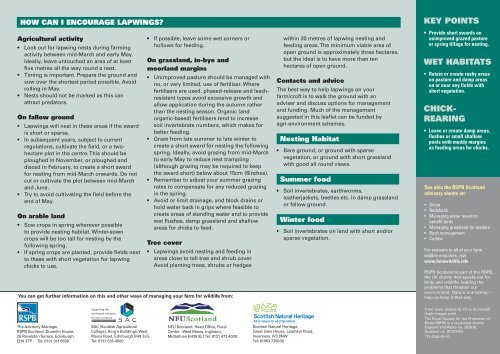Lapwing advisory sheet - RSPB
Lapwing advisory sheet - RSPB
Lapwing advisory sheet - RSPB
You also want an ePaper? Increase the reach of your titles
YUMPU automatically turns print PDFs into web optimized ePapers that Google loves.
HOW CAN I ENCOURAGE LAPWINGS?<br />
Agricultural activity<br />
• Look out for lapwing nests during farming<br />
activity between mid-March and early May.<br />
Ideally, leave untouched an area of at least<br />
five metres all the way round a nest.<br />
• Timing is important. Prepare the ground and<br />
sow over the shortest period possible. Avoid<br />
rolling in May.<br />
• Nests should not be marked as this can<br />
attract predators.<br />
On fallow ground<br />
• <strong>Lapwing</strong>s will nest in these areas if the sward<br />
is short or sparse.<br />
• In subsequent years, subject to current<br />
regulations, cultivate the field, or a twohectare<br />
plot in the centre. This should be<br />
ploughed in November, or ploughed and<br />
disced in February, to create a short sward<br />
for nesting from mid-March onwards. Do not<br />
cut or cultivate the plot between mid-March<br />
and June.<br />
• Try to avoid cultivating the field before the<br />
end of May.<br />
On arable land<br />
• Sow crops in spring wherever possible<br />
to provide nesting habitat. Winter-sown<br />
crops will be too tall for nesting by the<br />
following spring.<br />
• If spring crops are planted, provide fields next<br />
to these with short vegetation for lapwing<br />
chicks to use.<br />
• If possible, leave some wet corners or<br />
hollows for feeding.<br />
On grassland, in-bye and<br />
moorland margins<br />
• Unimproved pasture should be managed with<br />
no, or very limited, use of fertiliser. Where<br />
fertilisers are used, phased-release and leachresistant<br />
types avoid excessive growth and<br />
allow application during the autumn rather<br />
than the nesting season. Organic (and<br />
organic-based) fertilisers tend to increase<br />
soil invertebrate numbers, which makes for<br />
better feeding.<br />
• Graze from late summer to late winter to<br />
create a short sward for nesting the following<br />
spring. Ideally, avoid grazing from mid-March<br />
to early May to reduce nest trampling<br />
(although grazing may be required to keep<br />
the sward short) below about 15cm (6inches).<br />
• Remember to adjust your summer grazing<br />
rates to compensate for any reduced grazing<br />
in the spring.<br />
• Avoid or limit drainage, and block drains or<br />
hold water back in grips where feasible to<br />
create areas of standing water and to provide<br />
wet flushes, damp grassland and shallow<br />
areas for chicks to feed.<br />
Tree cover<br />
• <strong>Lapwing</strong>s avoid nesting and feeding in<br />
areas close to tall tree and shrub cover.<br />
Avoid planting trees, shrubs or hedges<br />
You can get further information on this and other ways of managing your farm for wildlife from:<br />
within 30 metres of lapwing nesting and<br />
feeding areas. The minimum viable area of<br />
open ground is approximately three hectares,<br />
but the ideal is to have more than ten<br />
hectares of open ground.<br />
Contacts and advice<br />
The best way to help lapwings on your<br />
farm/croft is to walk the ground with an<br />
adviser and discuss options for management<br />
and funding. Much of the management<br />
suggested in this leaflet can be funded by<br />
agri-environment schemes.<br />
Nesting Habitat<br />
• Bare ground, or ground with sparse<br />
vegetation, or ground with short grassland<br />
with good all round views.<br />
Summer food<br />
• Soil invertebrates, earthworms,<br />
leatherjackets, beetles etc. in damp grassland<br />
or fallow ground.<br />
Winter food<br />
• Soil invertebrates on land with short and/or<br />
sparse vegetation.<br />
KEY POINTS<br />
• Provide short swards on<br />
unimproved grazed pasture<br />
or spring tillage for nesting.<br />
WET HABITATS<br />
• Retain or create rushy areas<br />
on pasture and damp areas<br />
on or near any fields with<br />
short vegetation.<br />
CHICK-<br />
REARING<br />
• Leave or create damp areas,<br />
flushes or small shallow<br />
pools with muddy margins<br />
as feeding areas for chicks.<br />
See also the <strong>RSPB</strong> Scotland<br />
<strong>advisory</strong> <strong>sheet</strong>s on:<br />
• Snipe<br />
• Redshank<br />
• Managing water levels to<br />
benefit birds<br />
• Managing grassland for waders<br />
• Rush management<br />
• Curlew<br />
For answers to all of your farm<br />
wildlife enquiries, visit<br />
www.farmwildlife.info<br />
<strong>RSPB</strong> Scotland is part of the <strong>RSPB</strong>,<br />
the UK charity that speaks out for<br />
birds and wildlife, tackling the<br />
problems that threaten our<br />
environment. Nature is amazing –<br />
help us keep it that way.<br />
The Advisory Manager,<br />
<strong>RSPB</strong> Scotland, Dunedin House,<br />
25 Ravelston Terrace, Edinburgh<br />
EH4 3TP Tel: 0131 311 6500<br />
SAC (Scottish Agricultural<br />
College), King's Buildings, West<br />
Mains Road, Edinburgh EH9 3JG<br />
Tel: 0131 535 4000<br />
NFU Scotland, Head Office, Rural<br />
Centre - West Mains, Ingliston,<br />
Midlothian EH28 8LTTel: 0131 472 4000<br />
Scottish Natural Heritage,<br />
Great Glen House, Leachkin Road,<br />
Inverness, IV3 8NW<br />
Tel: 01463 725000<br />
Front cover picture by Chris Gomersall<br />
(rspb-images.com)<br />
The Royal Society for the Protection of<br />
Birds (<strong>RSPB</strong>) is a registered charity:<br />
England and Wales no. 207076,<br />
Scotland no. SC037654<br />
775-0140-09-10

















